2007 CHEVROLET IMPALA air condition
[x] Cancel search: air conditionPage 78 of 460

The passenger sensing system will turn off the
right front passenger’s frontal airbag under certain
conditions. The driver’s airbags are not part of
the passenger sensing system.
The passenger sensing system works with
sensors that are part of the right front passenger’s
seat and safety belt. The sensors are designed
to detect the presence of a properly seated
occupant and determine if the passenger’s frontal
airbag should be enabled (may in�ate) or not.
Accident statistics show that children are safer
if they are restrained in the rear rather than
the front seat. We recommend that child restraints
be secured in a rear seat, including an infant
riding in a rear-facing infant seat, a child riding
in a forward-facing child seat and an older
child riding in a booster seat.There is a label on your sun visor that says,
“Never put a rear-facing child seat in the front.”
This is because the risk to the rear-facing child is
so great if the airbag deploys. Never put a rear
facing child restraint in the right front passenger
seat unless the airbag is off. Here is why:
{CAUTION:
A child in a rear-facing child restraint
can be seriously injured or killed if the
right front passenger’s airbag in�ates.
This is because the back of the
rear-facing child restraint would be
very close to the in�ating airbag.
CAUTION: (Continued)
78
Page 118 of 460
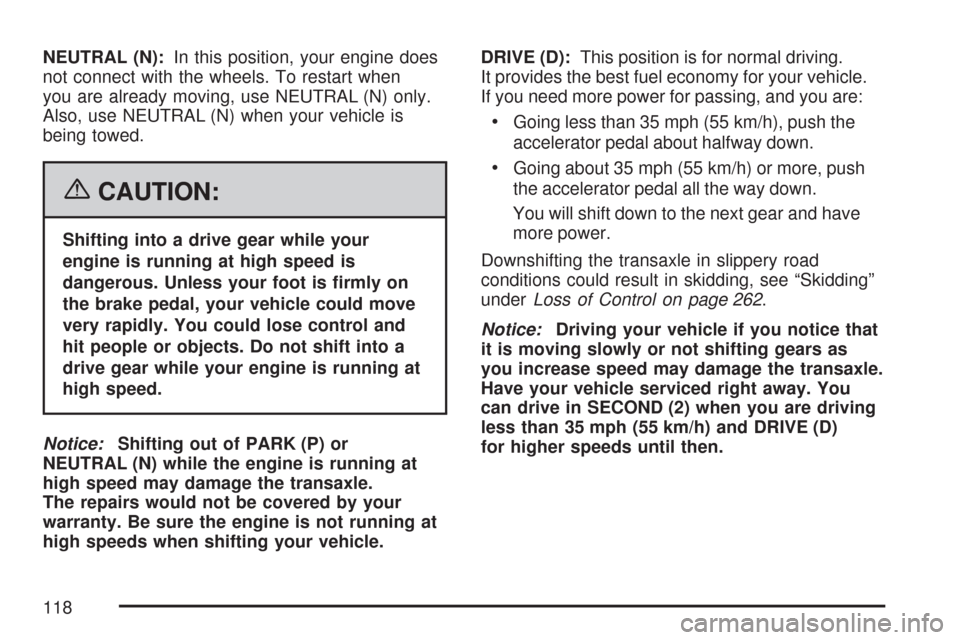
NEUTRAL (N):In this position, your engine does
not connect with the wheels. To restart when
you are already moving, use NEUTRAL (N) only.
Also, use NEUTRAL (N) when your vehicle is
being towed.
{CAUTION:
Shifting into a drive gear while your
engine is running at high speed is
dangerous. Unless your foot is �rmly on
the brake pedal, your vehicle could move
very rapidly. You could lose control and
hit people or objects. Do not shift into a
drive gear while your engine is running at
high speed.
Notice:Shifting out of PARK (P) or
NEUTRAL (N) while the engine is running at
high speed may damage the transaxle.
The repairs would not be covered by your
warranty. Be sure the engine is not running at
high speeds when shifting your vehicle.DRIVE (D):This position is for normal driving.
It provides the best fuel economy for your vehicle.
If you need more power for passing, and you are:
Going less than 35 mph (55 km/h), push the
accelerator pedal about halfway down.
Going about 35 mph (55 km/h) or more, push
the accelerator pedal all the way down.
You will shift down to the next gear and have
more power.
Downshifting the transaxle in slippery road
conditions could result in skidding, see “Skidding”
underLoss of Control on page 262.
Notice:Driving your vehicle if you notice that
it is moving slowly or not shifting gears as
you increase speed may damage the transaxle.
Have your vehicle serviced right away. You
can drive in SECOND (2) when you are driving
less than 35 mph (55 km/h) and DRIVE (D)
for higher speeds until then.
118
Page 128 of 460
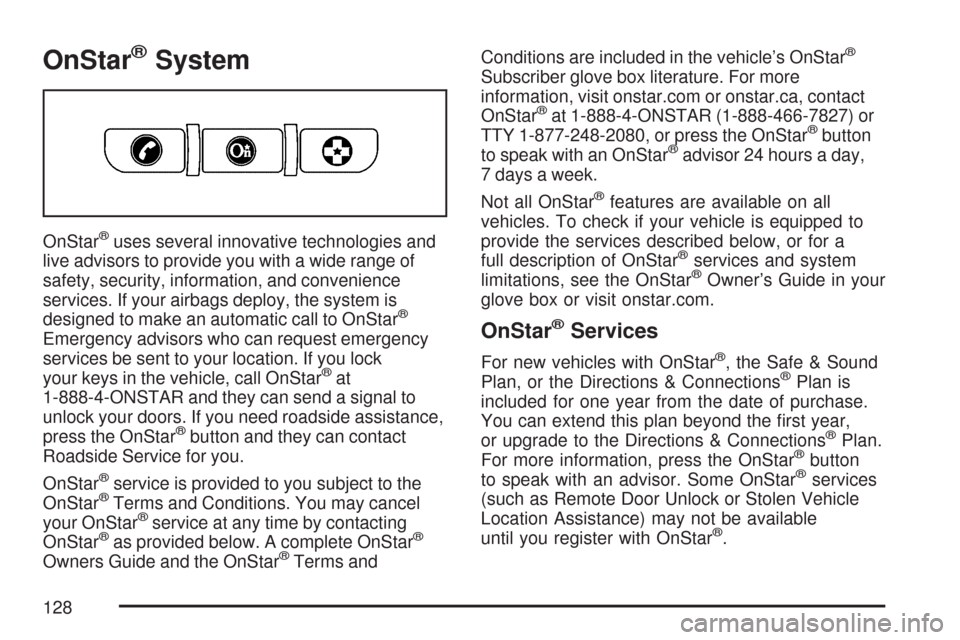
OnStar®System
OnStar®uses several innovative technologies and
live advisors to provide you with a wide range of
safety, security, information, and convenience
services. If your airbags deploy, the system is
designed to make an automatic call to OnStar
®
Emergency advisors who can request emergency
services be sent to your location. If you lock
your keys in the vehicle, call OnStar
®at
1-888-4-ONSTAR and they can send a signal to
unlock your doors. If you need roadside assistance,
press the OnStar
®button and they can contact
Roadside Service for you.
OnStar
®service is provided to you subject to the
OnStar®Terms and Conditions. You may cancel
your OnStar®service at any time by contacting
OnStar®as provided below. A complete OnStar®
Owners Guide and the OnStar®Terms andConditions are included in the vehicle’s OnStar
®
Subscriber glove box literature. For more
information, visit onstar.com or onstar.ca, contact
OnStar
®at 1-888-4-ONSTAR (1-888-466-7827) or
TTY 1-877-248-2080, or press the OnStar®button
to speak with an OnStar®advisor 24 hours a day,
7 days a week.
Not all OnStar
®features are available on all
vehicles. To check if your vehicle is equipped to
provide the services described below, or for a
full description of OnStar
®services and system
limitations, see the OnStar®Owner’s Guide in your
glove box or visit onstar.com.
OnStar®Services
For new vehicles with OnStar®, the Safe & Sound
Plan, or the Directions & Connections®Plan is
included for one year from the date of purchase.
You can extend this plan beyond the �rst year,
or upgrade to the Directions & Connections
®Plan.
For more information, press the OnStar®button
to speak with an advisor. Some OnStar®services
(such as Remote Door Unlock or Stolen Vehicle
Location Assistance) may not be available
until you register with OnStar
®.
128
Page 169 of 460
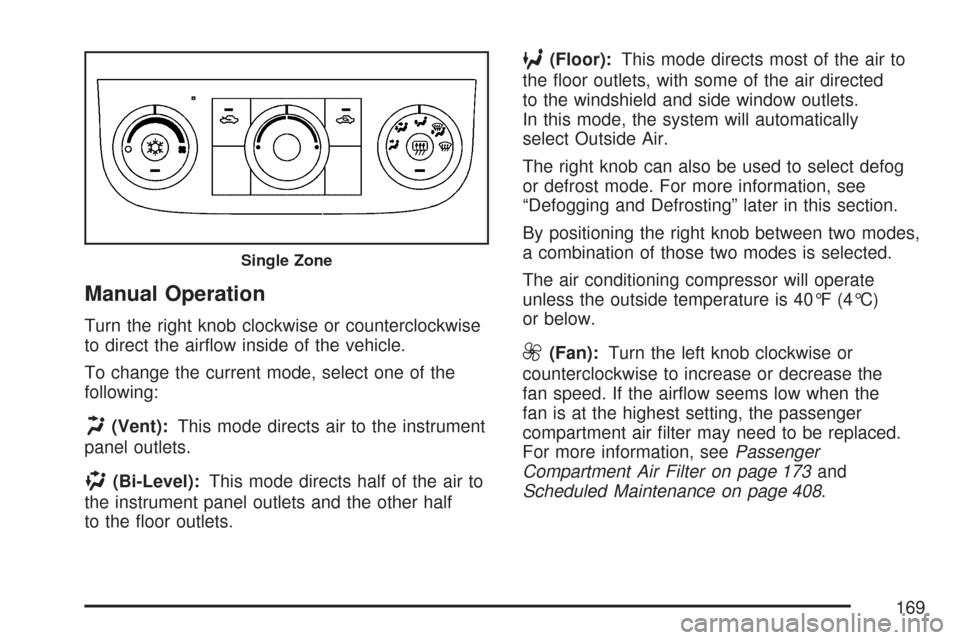
Manual Operation
Turn the right knob clockwise or counterclockwise
to direct the air�ow inside of the vehicle.
To change the current mode, select one of the
following:
H(Vent):This mode directs air to the instrument
panel outlets.
)(Bi-Level):This mode directs half of the air to
the instrument panel outlets and the other half
to the �oor outlets.
6(Floor):This mode directs most of the air to
the �oor outlets, with some of the air directed
to the windshield and side window outlets.
In this mode, the system will automatically
select Outside Air.
The right knob can also be used to select defog
or defrost mode. For more information, see
“Defogging and Defrosting” later in this section.
By positioning the right knob between two modes,
a combination of those two modes is selected.
The air conditioning compressor will operate
unless the outside temperature is 40°F (4°C)
or below.
9(Fan):Turn the left knob clockwise or
counterclockwise to increase or decrease the
fan speed. If the air�ow seems low when the
fan is at the highest setting, the passenger
compartment air �lter may need to be replaced.
For more information, seePassenger
Compartment Air Filter on page 173and
Scheduled Maintenance on page 408.
Single Zone
169
Page 170 of 460
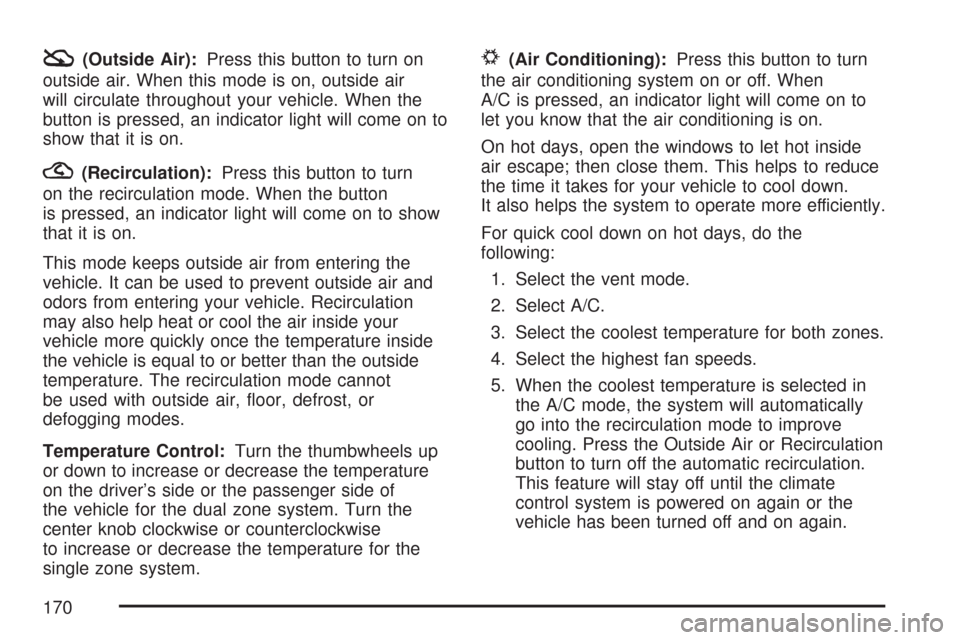
:(Outside Air):Press this button to turn on
outside air. When this mode is on, outside air
will circulate throughout your vehicle. When the
button is pressed, an indicator light will come on to
show that it is on.
?(Recirculation):Press this button to turn
on the recirculation mode. When the button
is pressed, an indicator light will come on to show
that it is on.
This mode keeps outside air from entering the
vehicle. It can be used to prevent outside air and
odors from entering your vehicle. Recirculation
may also help heat or cool the air inside your
vehicle more quickly once the temperature inside
the vehicle is equal to or better than the outside
temperature. The recirculation mode cannot
be used with outside air, �oor, defrost, or
defogging modes.
Temperature Control:Turn the thumbwheels up
or down to increase or decrease the temperature
on the driver’s side or the passenger side of
the vehicle for the dual zone system. Turn the
center knob clockwise or counterclockwise
to increase or decrease the temperature for the
single zone system.
#(Air Conditioning):Press this button to turn
the air conditioning system on or off. When
A/C is pressed, an indicator light will come on to
let you know that the air conditioning is on.
On hot days, open the windows to let hot inside
air escape; then close them. This helps to reduce
the time it takes for your vehicle to cool down.
It also helps the system to operate more efficiently.
For quick cool down on hot days, do the
following:
1. Select the vent mode.
2. Select A/C.
3. Select the coolest temperature for both zones.
4. Select the highest fan speeds.
5. When the coolest temperature is selected in
the A/C mode, the system will automatically
go into the recirculation mode to improve
cooling. Press the Outside Air or Recirculation
button to turn off the automatic recirculation.
This feature will stay off until the climate
control system is powered on again or the
vehicle has been turned off and on again.
170
Page 171 of 460

Using these settings together for long periods of
time may cause the air inside of your vehicle
to become too dry. To prevent this from
happening, after the air inside of your vehicle has
cooled, turn the recirculation mode off.
The air conditioning system removes moisture
from the air, so you may sometimes notice a small
amount of water dripping underneath your
vehicle while idling or after turning off the engine.
This is normal.
Defogging and Defrosting
Fog on the inside of the windows is a result of
high humidity (moisture) condensing on the
cool window glass. This can be minimized if the
climate control system is used properly. There are
two modes to clear fog or frost from your
windshield. Use the defog mode to clear the
windows of fog or moisture and warm the
passengers. Use the defrost mode to remove fog
or frost from the windshield more quickly.Do not drive the vehicle until all the windows
are clear.
Turn the right knob clockwise to select the defog
or defrost mode.
-(Defog):This mode directs air equally to the
windshield and the �oor outlets. When defog
is selected, the system turns off recirculation and
runs the air conditioning compressor unless
the outside temperature is below 40°F (4°C).
0(Defrost):This mode directs most of the air to
the windshield with some air to the side window
vents and the �oor vents. When defrost is selected,
the system will automatically force outside air into
the vehicle. The air conditioning compressor will run
automatically in this setting, unless the outside
temperature is below 40°F (4°C).
171
Page 172 of 460
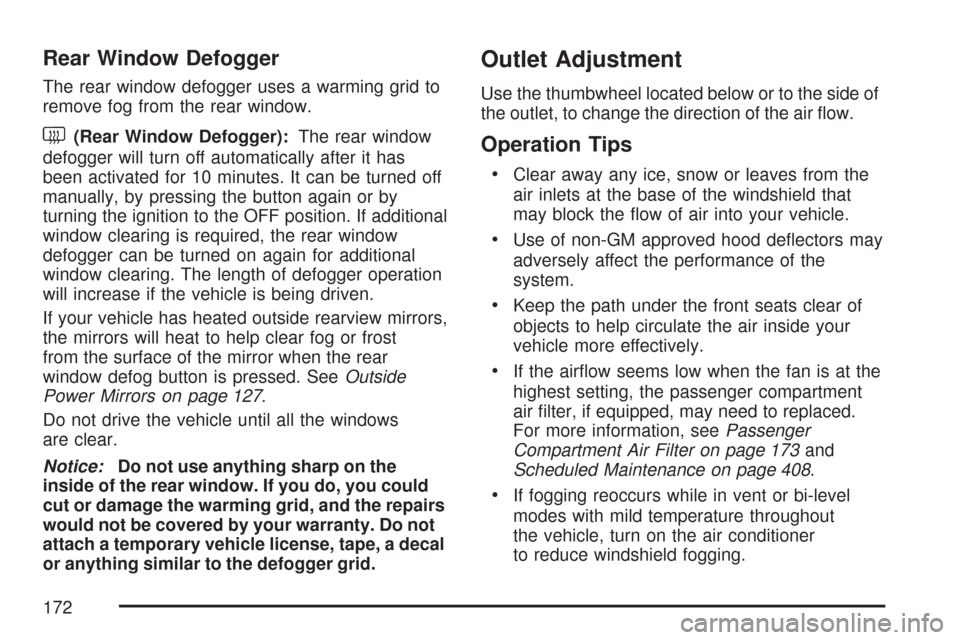
Rear Window Defogger
The rear window defogger uses a warming grid to
remove fog from the rear window.
<(Rear Window Defogger):The rear window
defogger will turn off automatically after it has
been activated for 10 minutes. It can be turned off
manually, by pressing the button again or by
turning the ignition to the OFF position. If additional
window clearing is required, the rear window
defogger can be turned on again for additional
window clearing. The length of defogger operation
will increase if the vehicle is being driven.
If your vehicle has heated outside rearview mirrors,
the mirrors will heat to help clear fog or frost
from the surface of the mirror when the rear
window defog button is pressed. SeeOutside
Power Mirrors on page 127.
Do not drive the vehicle until all the windows
are clear.
Notice:Do not use anything sharp on the
inside of the rear window. If you do, you could
cut or damage the warming grid, and the repairs
would not be covered by your warranty. Do not
attach a temporary vehicle license, tape, a decal
or anything similar to the defogger grid.
Outlet Adjustment
Use the thumbwheel located below or to the side of
the outlet, to change the direction of the air �ow.
Operation Tips
Clear away any ice, snow or leaves from the
air inlets at the base of the windshield that
may block the �ow of air into your vehicle.
Use of non-GM approved hood de�ectors may
adversely affect the performance of the
system.
Keep the path under the front seats clear of
objects to help circulate the air inside your
vehicle more effectively.
If the air�ow seems low when the fan is at the
highest setting, the passenger compartment
air �lter, if equipped, may need to replaced.
For more information, seePassenger
Compartment Air Filter on page 173and
Scheduled Maintenance on page 408.
If fogging reoccurs while in vent or bi-level
modes with mild temperature throughout
the vehicle, turn on the air conditioner
to reduce windshield fogging.
172
Page 181 of 460

Charging System Light
The charging system
light will come on brie�y
when you turn on
the ignition, but the
engine is not running,
as a check to show you
it is working.
It should go out once the engine is running.
If it stays on, or comes on while you are driving,
you may have a problem with the charging system.
It could indicate that you have problems with a
generator drive belt, or another electrical problem.
Have it checked right away. Driving while this
light is on could drain your battery.
If you must drive a short distance with the light on,
be certain to turn off all your accessories, such
as the radio and air conditioner.
Brake System Warning Light
Your vehicle’s hydraulic brake system is divided
into two parts. If one part is not working, the other
part can still work and stop you. For good braking,
though, you need both parts working well.
If the warning light comes on, there is a brake
problem. Have your brake system inspected
right away.
This light should come on brie�y when you turn
the ignition key to RUN. If it does not come
on then, have it �xed so it will be ready to warn
you if there is a problem.
United StatesCanada
181